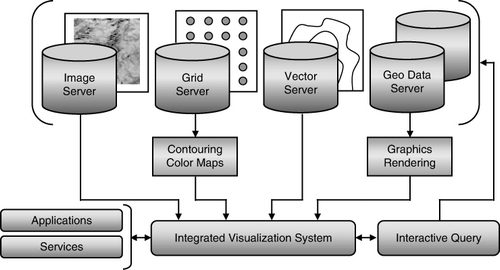Figures & data

![Figure 2. Satellite imagery [Landsat 7, bands 2, 4, and 7, Source: National Aeronautics and Space Administration (NASA)] overlaid with colored contours of topography [30 arc-seconds Shuttle Radar Topography Mission (SRTM30), Source: National Geospatial-Intelligence Agency (NGA) and NASA] and black contours of gravity [Source: Pakistan Geophysical Database]. A sedimentary basin was demarcated with an orange line by identifying the zone of low gravity.](/cms/asset/ba7037c3-e965-46c4-837c-c1f1d6f415e8/tjde_a_638990_f0002_oc.jpg)
![Figure 3. Satellite Imagery [Landsat 7, bands 2, 4, and 7, Source: National Aeronautics and Space Administration (NASA)] with three exploration data layers; lease concessions polygons, seismic lines (yellow lines with purple pickets) and wells (red circles) [Source: Pakistan Exploration Database]. A 3D seismic survey grid was planned in the lower-left area using interactive seismic survey design tools.](/cms/asset/184363c5-6abb-4c72-8e7a-9b5545ce345c/tjde_a_638990_f0003_oc.jpg)
![Figure 4. Shaded relief map generated from Digital Elevation Model [3 arc-seconds Shuttle Radar Topography Mission (SRTM3), Source: National Geospatial-Intelligence Agency (NGA) and National Aeronautics and Space Administration (NASA)] overlaid with structural faults (pink lines) [Source: Pakistan Geophysical Database], earthquake epicenters (green, blue, and red dots) [Source: National Earthquake Information Center (NEIC), US Geological Survey] and administrative boundaries of Pakistan (yellow). A seismic hazard zones map was generated by analyzing the faults and earthquakes patterns. It highlights four seismic risk zones; minor (green), minor to moderate (blue), moderate (orange) and severe (red).](/cms/asset/fb6b8f0d-4017-49e1-988e-60db4828cb4f/tjde_a_638990_f0004_oc.jpg)
![Figure 5. (Upper-left) Colored topographic map with administrative boundaries of Pakistan (yellow). (Lower-right) The same map with rivers and a superimposed partially transparent image of drainage pattern, computed from Digital Elevation Model [3 arc-seconds Shuttle Radar Topography Mission (SRTM3), Source: National Geospatial-Intelligence Agency (NGA) and National Aeronautics and Space Administration (NASA)].](/cms/asset/bdb6c960-d3cb-4b14-802d-8c0868801604/tjde_a_638990_f0005_oc.jpg)
Register now or learn more
Free access

![Figure 2. Satellite imagery [Landsat 7, bands 2, 4, and 7, Source: National Aeronautics and Space Administration (NASA)] overlaid with colored contours of topography [30 arc-seconds Shuttle Radar Topography Mission (SRTM30), Source: National Geospatial-Intelligence Agency (NGA) and NASA] and black contours of gravity [Source: Pakistan Geophysical Database]. A sedimentary basin was demarcated with an orange line by identifying the zone of low gravity.](/cms/asset/ba7037c3-e965-46c4-837c-c1f1d6f415e8/tjde_a_638990_f0002_oc.jpg)
![Figure 3. Satellite Imagery [Landsat 7, bands 2, 4, and 7, Source: National Aeronautics and Space Administration (NASA)] with three exploration data layers; lease concessions polygons, seismic lines (yellow lines with purple pickets) and wells (red circles) [Source: Pakistan Exploration Database]. A 3D seismic survey grid was planned in the lower-left area using interactive seismic survey design tools.](/cms/asset/184363c5-6abb-4c72-8e7a-9b5545ce345c/tjde_a_638990_f0003_oc.jpg)
![Figure 4. Shaded relief map generated from Digital Elevation Model [3 arc-seconds Shuttle Radar Topography Mission (SRTM3), Source: National Geospatial-Intelligence Agency (NGA) and National Aeronautics and Space Administration (NASA)] overlaid with structural faults (pink lines) [Source: Pakistan Geophysical Database], earthquake epicenters (green, blue, and red dots) [Source: National Earthquake Information Center (NEIC), US Geological Survey] and administrative boundaries of Pakistan (yellow). A seismic hazard zones map was generated by analyzing the faults and earthquakes patterns. It highlights four seismic risk zones; minor (green), minor to moderate (blue), moderate (orange) and severe (red).](/cms/asset/fb6b8f0d-4017-49e1-988e-60db4828cb4f/tjde_a_638990_f0004_oc.jpg)
![Figure 5. (Upper-left) Colored topographic map with administrative boundaries of Pakistan (yellow). (Lower-right) The same map with rivers and a superimposed partially transparent image of drainage pattern, computed from Digital Elevation Model [3 arc-seconds Shuttle Radar Topography Mission (SRTM3), Source: National Geospatial-Intelligence Agency (NGA) and National Aeronautics and Space Administration (NASA)].](/cms/asset/bdb6c960-d3cb-4b14-802d-8c0868801604/tjde_a_638990_f0005_oc.jpg)
Please note: Selecting permissions does not provide access to the full text of the article, please see our help page How do I view content?
To request a reprint or corporate permissions for this article, please click on the relevant link below:
Please note: Selecting permissions does not provide access to the full text of the article, please see our help page How do I view content?
Obtain permissions instantly via Rightslink by clicking on the button below:
If you are unable to obtain permissions via Rightslink, please complete and submit this Permissions form. For more information, please visit our Permissions help page.
People also read lists articles that other readers of this article have read.
Recommended articles lists articles that we recommend and is powered by our AI driven recommendation engine.
Cited by lists all citing articles based on Crossref citations.
Articles with the Crossref icon will open in a new tab.